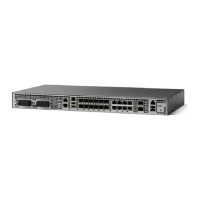Configuring a Virtual Loopback Interface
This task explains how to configure a basic loopback interface.
The IP address of a loopback interface must be unique across all routers on the network. It must not be used
by another interface on the router, and it must not be used by an interface on any other router on the network.
SUMMARY STEPS
1.
configure terminal
2.
interface loopback interface-path-id
3.
ipv4 address ip-address
4.
end
5.
show interfaces type interface-path-id
DETAILED STEPS
PurposeCommand or Action
Enters global configuration mode.configure terminal
Example:
Router# configure terminal
Step 1
Enters interface configuration mode and names the new loopback interface.
interface loopback interface-path-id
Example:
Router#(config)# interface Loopback
3
Step 2
Assigns an IP address and subnet mask to the virtual loopback interface
using the ipv4 address configuration command.
ipv4 address ip-address
Example:
Router(config-if)# ipv4 address
172.18.189.38
Step 3
Saves configuration changes. When you issue the end command, the system
prompts you to commit changes:
Uncommitted changes found, commit them before
end
Example:
Router(config-if)# end
Step 4
exiting(yes/no/cancel)?
[cancel]:
•
Entering yes saves configuration changes to the running configuration
file, exits the configuration session, and returns the router to EXEC
mode.
•
Entering no exits the configuration session and returns the router to
EXEC mode without committing the configuration changes.
•
Entering cancel leaves the router in the current configuration session
without exiting or committing the configuration changes.
MPLS Basic Configuration Guide, Cisco IOS XE Everest 16.5.1 (Cisco ASR 900 Series)
120
VPLS Configuration over MPLS-TP
Configuring a Virtual Loopback Interface

